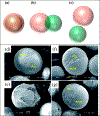Interfacial tension effects on the properties of PLGA microparticles
- PMID: 32919245
- PMCID: PMC7708423
- DOI: 10.1016/j.colsurfb.2020.111300
Interfacial tension effects on the properties of PLGA microparticles
Abstract
Many types of long-acting injectables, including in situ forming implants, preformed implants, and polymeric microparticles, have been developed and ultimately benefited numerous patients. The advantages of using long-acting injectables include greater patient compliance and more steady state drug plasma levels for weeks and months. However, the development of long-acting polymeric microparticles has been hampered by the lack of understanding of the microparticle formation process, and thus, control of the process. Of the many parameters critical to the reproducible preparation of microparticles, the interfacial tension (IFT) effect is an important factor throughout the process. It may influence the droplet formation, solvent extraction, and drug distribution in the polymer matrix, and ultimately drug release kinetics from the microparticles. This mini-review is focused on the IFT effects on drug-loaded poly(lactic-co-glycolic acid) (PLGA) microparticles.
Keywords: Interfacial tension; PLGA microparticles; Processing parameters; Solvent extraction.
Copyright © 2020 Elsevier B.V. All rights reserved.
Figures


References
-
- Gilding DK, Reed AM, Biodegradable polymers for use in surgery—polyglycolic/poly(actic acid) homo- and copolymers: 1, Polymer, 20 (1979) 1459–1464.
-
- Kulkarni RK, Pani KC, Neuman C, Leonard F, Polylactic Acid for Surgical Implants, JAMA Surgery, 93 (1966) 839–843. - PubMed
-
- Cutright DE, Hunsuck EE, Tissue reaction to the biodegradable polylactic acid suture, Oral Surgery, Oral Medicine, Oral Pathology, 31 (1971) 134–139. - PubMed
-
- Cutright DE, Hunsuck EE, Beasley JD, Fracture reduction using a biodegradable material, polylactic acid, Journal of oral surgery (American Dental Association : 1965), 29 (1971) 393. - PubMed
Publication types
MeSH terms
Substances
Grants and funding
LinkOut - more resources
Full Text Sources

